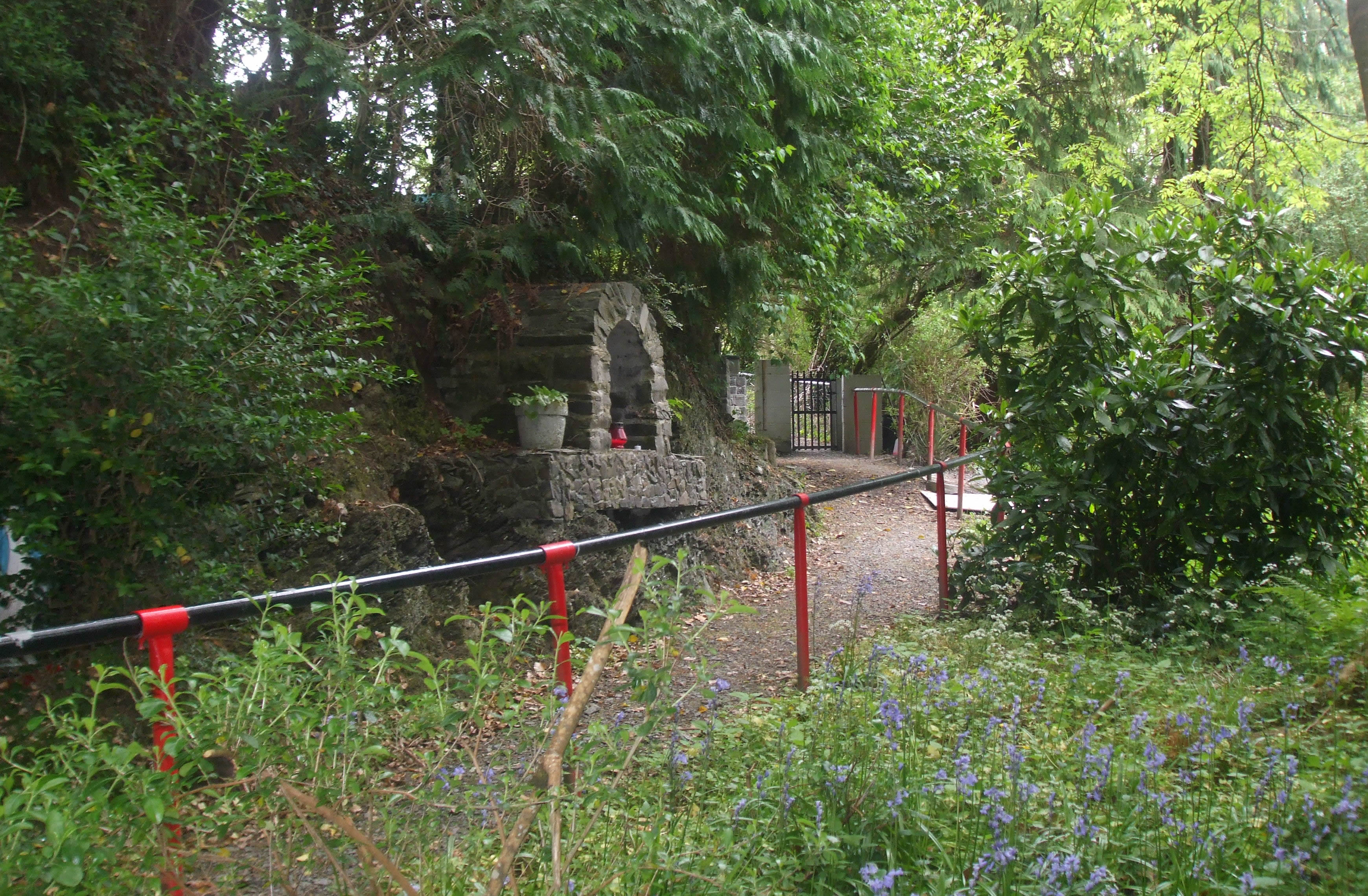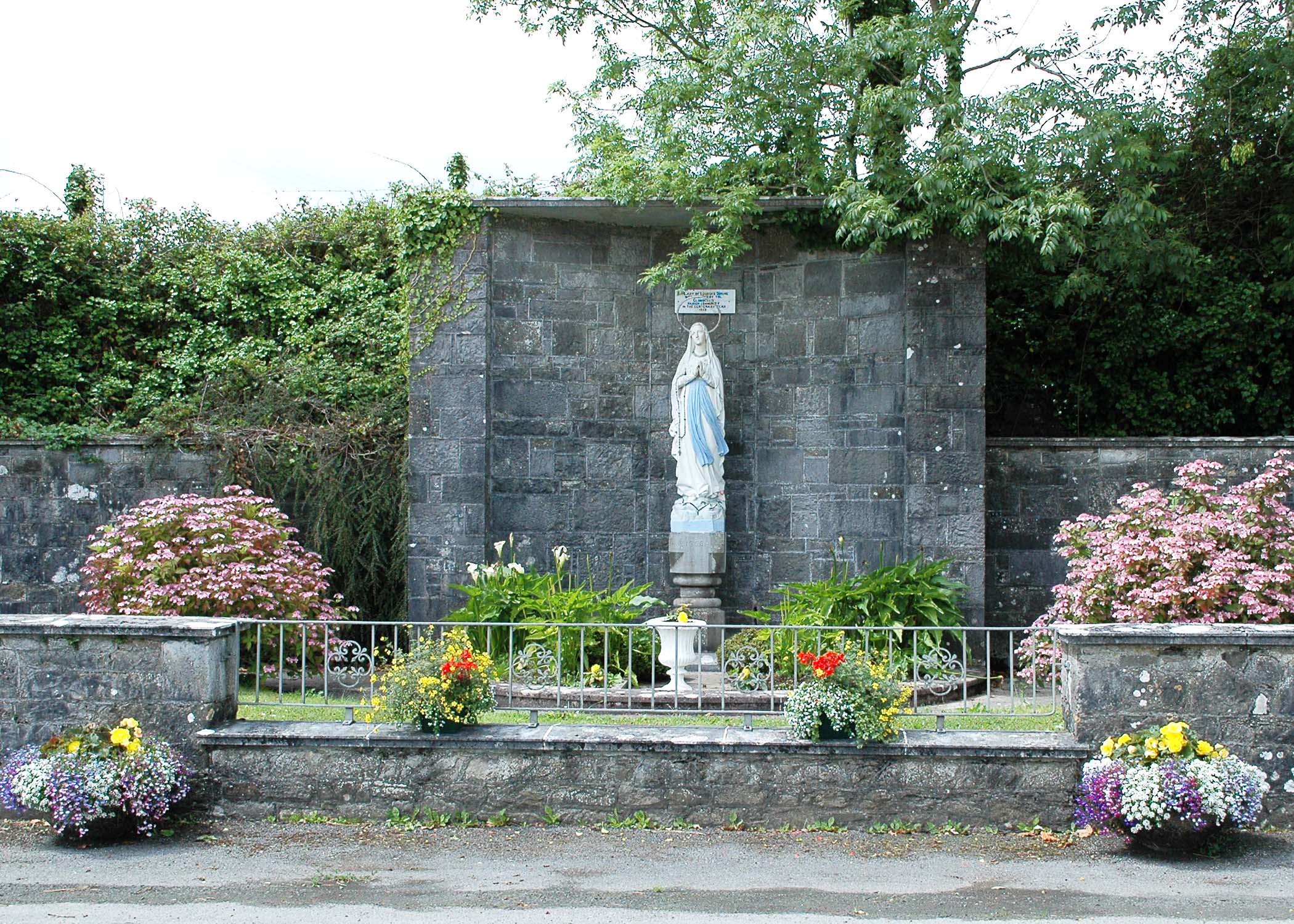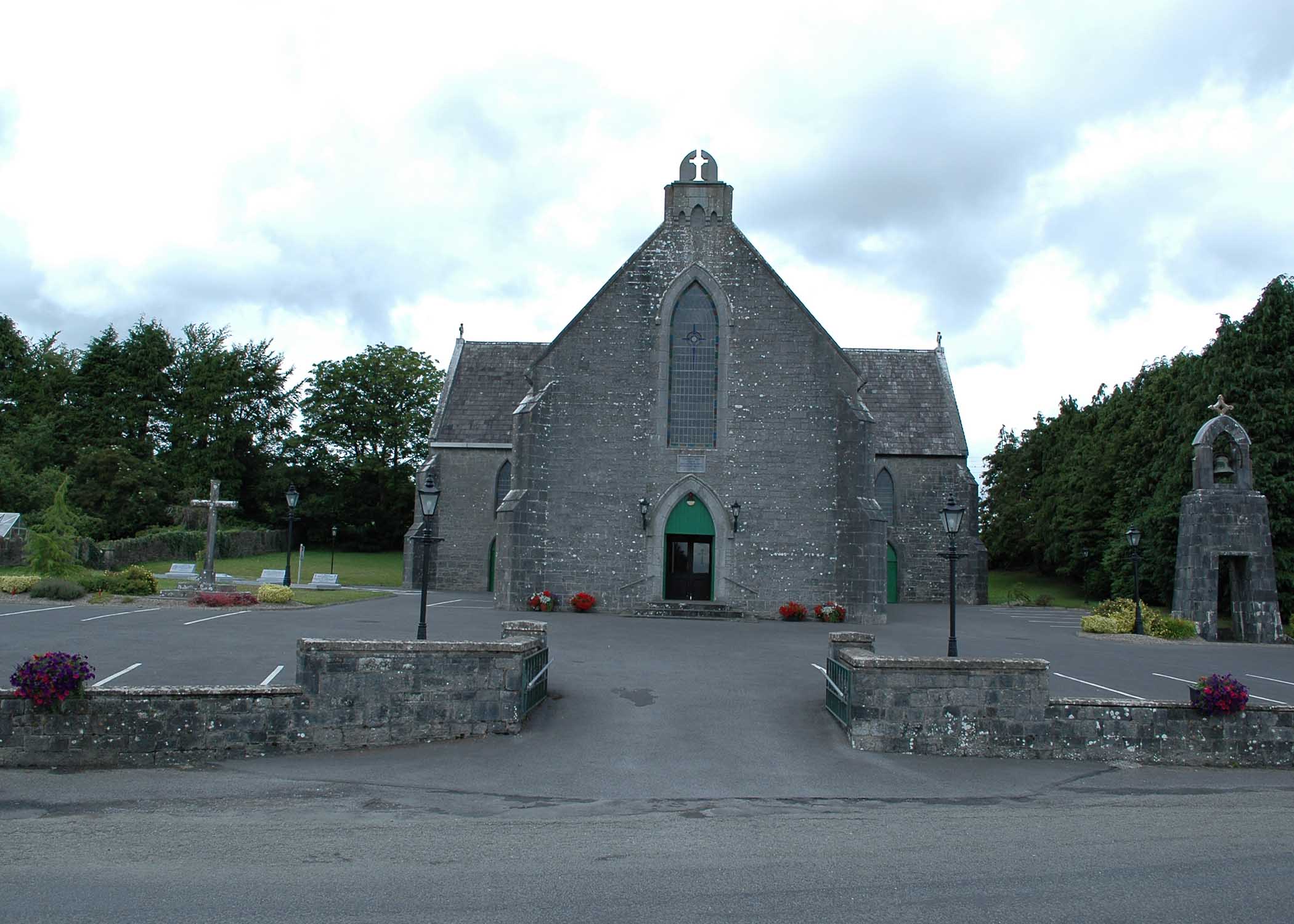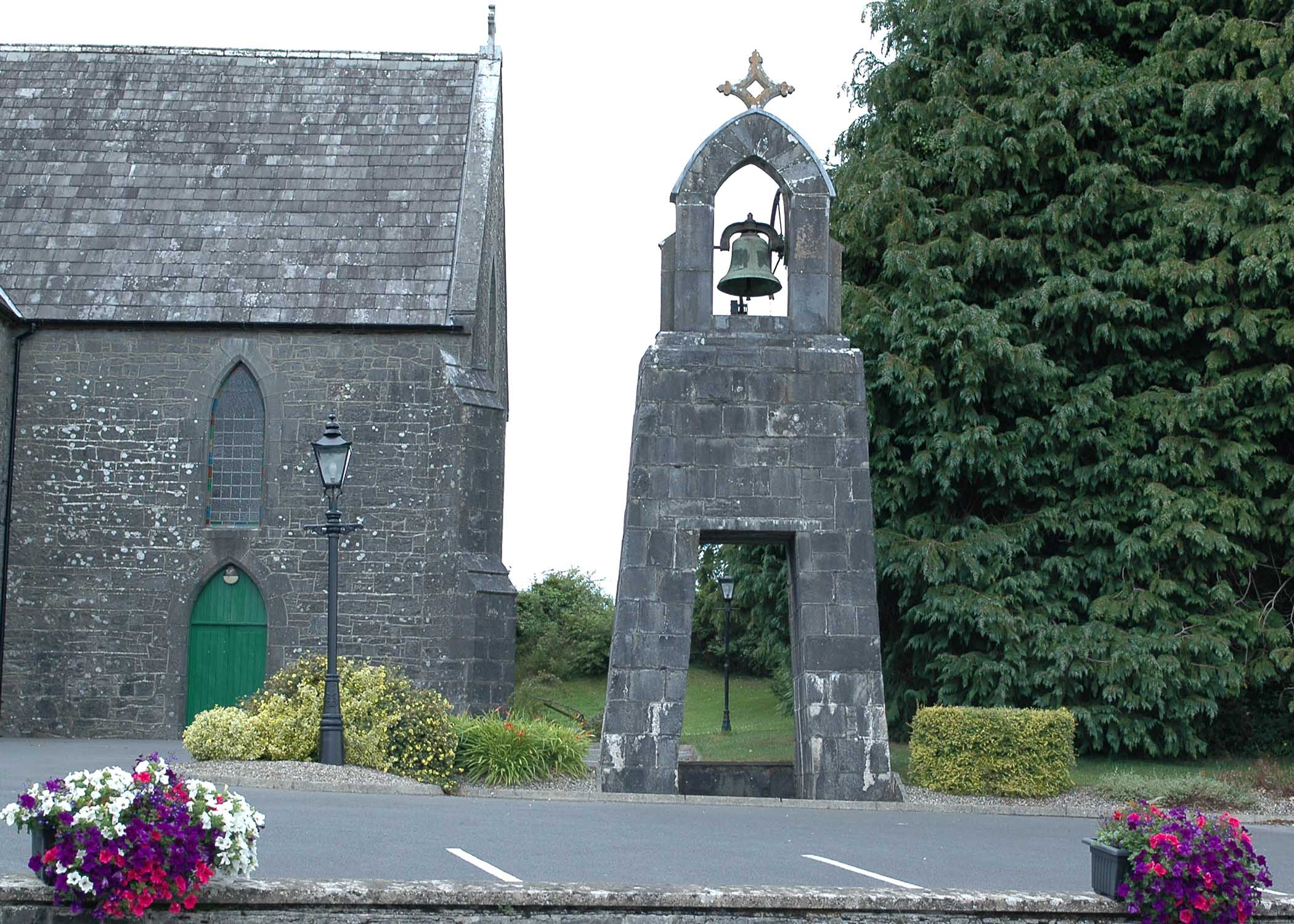"In prayer it is better to have a heart without words than words without a heart."-
John Bunyan

History of Ballynacally
Ballynacally is a picturesque village situated approx. 10miles south west of Ennis, on the coast road to Kilrush. It is the custom of the villagers, and the people of the surrounding areas to make an
annual visit to a Blessed Well outside the village, which is dedicated to St. Martin, patron of Gaul in France. St. Martin’s Shrine and Holy Well can be reached by a path from the road in a matter of minutes. The clear spring well is overhung by a concrete alter, on top of which stands, in a niche, a beautiful statue if St. Martin. The well and shrine is located in just the sort of seclusion that had always in his lifetime an irresistible appeal for the Saint. The Shrine, hollowed in a rocky area on the brink of a gently flowing stream, is sheltered by stately cypress trees and flowering shrubs. On St. Martin’s Day 11thNovember, every year, it is an inspiring sight to see the constant stream of pilgrims make their way to the shrine, some old, many in the full flush of youth, but all with a deep faith in the ability of the Saint to cure their ills.
They kneel on the concrete surface of the sanctuary and pray and light candles. Only the murmur of the waters and an occasional gust of wind through the trees disturbs the silence. Before leaving, they drink the refreshing waters from the well, and in a little pool nearby into which there is a constant flow of water from the well, they bathe their eyes. It is widely believed that blindness, rheumatism and many minor ailments can be cured here, and at all times throughout the year people suffering from various complaints make novenas here in supplication to the Saint.
St. Martin was born in Italy in 316, reared in Milan and came to Gaul as a soldier. At the age of eighteen, he was baptised and having become a disciple of St. Hilary, he founded a monastery in Liguage, near Poitiers. Many years later, he was made Bishop of Tours, near which he founded the famous Abbey of Marmontiers or Martin’s Monastery. His fame was first brought to Ireland by his friend, St. Ninian, who knew and loved St. Martinand who founded a monastery like those in France at Whitburn , in Scotland in 397. The Monastery of Candida Casa had much to do with the spread of monasticism to Ireland. St. Martin lived ‘till he was nearly eighty years old. His death occurred in Candes, near Tours, on November 8th 397. His tomb is famous through many miracles and attracts large numbers of visitors.
50th Anniversary of the Blessing of Ballynacally Shrine – Sept.1958
2008 marks the 50th Anniversary of the Shrine in Ballynacally. Mass was celebrated in the GAA pitch, Ballynacally, in view of the S hrine, on Fri.May 2nd to celebrate its building fifty years ago.
hrine, on Fri.May 2nd to celebrate its building fifty years ago.
The Shrine was built by voluntary labour and has been maintained on a voluntary basis since then.
On Sept.27th 1958, Bishop Rodgers blessed the Shrine after a votive Mass Ballycorick Church. This Mass was celebrated by Rev. R. Carey, C.C. Present also were Canon Hogan, P.P. Clarecastle, Rev. T. Daly. P.P. Kildysart, Rev. Pat O’Donoghue, P.P. Clondegad, Rev. J. O’Leary, C.C. Clondegad and Rev. D. Kelly, C.C. Ennis. School children from the seven schools in the parish sang at the Mass. After the Mass, parishioners walked in procession to the Shrine. At the blessing, Dr. Rogers said ‘When we of this generation have passed away, this beautiful Shrine that you yourselves have built, will stand as a memorial to your love and affection for Our Lady of Lourdes.’
Let us pray for and be grateful to all of those who were involved in the building maintaining of our Shrine over the last fifty years.
The History of Ballycorick Church
150 Years Old
Our parish was formed from the medieval parishes of Clondegad and Kilchreest and they have been administered together since the late seventeenth century at least. Two of the Islands in the Fergus Estuary – Coney Island (Inishdadroum) and Deer Island (Inis Mor) are included in the parish of Kilchreest. James Frost in his notes on the parishes includes Coney Island in Kildysart parish, but in his list of townlands in 1641, it is included in Clondegad parish, being then the property of the Earl of Thomond. In 1664 its rated occupier was Nicholus Parsons.[1]
late seventeenth century at least. Two of the Islands in the Fergus Estuary – Coney Island (Inishdadroum) and Deer Island (Inis Mor) are included in the parish of Kilchreest. James Frost in his notes on the parishes includes Coney Island in Kildysart parish, but in his list of townlands in 1641, it is included in Clondegad parish, being then the property of the Earl of Thomond. In 1664 its rated occupier was Nicholus Parsons.[1]
In 1704, in the reign of Queen Anne, every Catholic priest remaining in Ireland was ordered to register his name, abode, age and parish. The registration took place in Ennis on 11th July 1704. Each priest had also to provide two sureties to be of good behaviour. The parish priest of Clondegad on this occasion was Rev. Thomas Cloghassy and his sureties were Turlough O’Brien, Ballycorick and Captain Peter Aylmer, Cragbrien.[2]
Local tradition tells us that there were Mass houses in Mount, Lanna, Lavalla and Gurtygeheen at various times during the eighteenth and nineteenth centuries and possibly earlier. There are no visible remains of the Mount Mass house which stood on the old road leading through Knapogue and Mount from Ballycorick Bridge to the Poulaphuca Lavalla road. It stood on the south west corner of the third field, coming from the four cross roads ar Garry’s shop, on the right hand side, a thatched oblong building.[3]
Fr. Timothy Breen was P.P from 1846 to 1853 and it was during this time that both the birth and marriage registers were commenced. These were also the famine years so the place of worship continued to be a ‘few wretched cabins knocked together to make a temporary chapel’.[4]
In 1853 Fr. Michael Dinan was appointed P.P. of Ballynacally. It would appear that he was a very active man both politically and religiously. During his tenure two churches were built within a very short space of time and he was also active in the O’ Connell Monument committee in Ennis.[5] It could be suggested that contacts made politically were of benefit when it came to fundraising in his own parish.
On 26th March 1858 it was reported in the newspaper - Limerick Reporter and Tipperary Vindicator – that a site for a new church had been given by Thomas Rice Henn of Paradise. The same gentleman also gave £50 towards the building, a considerable sum at that time.[6] The same newspaper reported that in October 1859 the people of Ogonnelloe donated £17 including £1 from the pastor Rev. Michael Bourke for a new church in Ballynacally.[7] The neighbouring
parishes of Kildysart and Coolmeen were not found wanting and in March 1860 they gave £36.13.3 towards the fund.[8] In May of the same year the people of Tulla donated £30 towards the building fund.[9]
One may be permitted to assume that collections took place in other parishes also and at fairs and markets as was the custom of the time. It could be also reasonable to suggest that contributions came from overseas, from emigrants from the parish or from their descendants.
In April 1858 tenders were sought for the building of the church which was designed by W.E. Corbett, Esq. C.E. [10] The building was to be 108ft long, 35ft wide and transept about 65ft. There were to be two lateral chapels, a decorated rose window at each end with a statue in front, a side porch and buttresses – The entire cost was estimated to be about £1500.[11] No record was found of who the builder was but one deceased local man was of the opinion that it was a man named Harte and to keep his memory alive he inserted a stone in the shape of a heart in the surrounding wall. Incidentally this stone can still be seen today so it is an interesting theory. [12]
When one considers that this was barely ten years since the famine and also that a church was being built in Lissycasey at more or less the same time, one might have some idea of the enormity of the task. However, on going through the diocesan records of the 1850’s it can be seen that this was a period of church building and church renovation in the Killaloe Diocese. New churches were built in Dysart, Inagh and Cree and restoration work was carried out in many more.[13]
Ballycorick Church was dedicated to Christ the King on 17th February 1861 by Bishop Flannnery of Killaloe. It has  been suggested that Christ the King was in commemoration of the old church of Christ at Kilchreest. The sermon on the occasion was preached by Fr. O’Brien P.P.V.F, Kilfinane, and founder of the Young Men’s Societies. It was customary at the time to bring a well-known cleric to preach in the hope that many from outside the parish would attend and so add to the collection on the day. In the case of Ballynacally it was hoped that “many of the pious Catholic inhabitants of Ennis will visit the new chapel and as the inhabitants of Ballynacally and the Ennisites have always been on friendly terms and have some commercial dealings together, perhaps the latter would remember these things and by their donations help to complete the work” . The collection on that Sunday in 1861 amounted to £160 so one can only imagine the number in attendance on the day.[14]
been suggested that Christ the King was in commemoration of the old church of Christ at Kilchreest. The sermon on the occasion was preached by Fr. O’Brien P.P.V.F, Kilfinane, and founder of the Young Men’s Societies. It was customary at the time to bring a well-known cleric to preach in the hope that many from outside the parish would attend and so add to the collection on the day. In the case of Ballynacally it was hoped that “many of the pious Catholic inhabitants of Ennis will visit the new chapel and as the inhabitants of Ballynacally and the Ennisites have always been on friendly terms and have some commercial dealings together, perhaps the latter would remember these things and by their donations help to complete the work” . The collection on that Sunday in 1861 amounted to £160 so one can only imagine the number in attendance on the day.[14]
Fr. Dinan also acknowledged “the liberality of many Protestants” who assisted them with their subscriptions. The local newspaper, Clare Journal, was fulsome in its praise of Fr. Dinan who “although laboring under the greatest disadvantage from the remoteness of the locality from any place where the necessary materials for so great a work could be procured and the want of adequate means, had succeeded by indomitable perseverance in erecting a suitable temple for the Lord in this small and rather poor parish”.[15]
The plaque over the main door of the church bears the following inscription; Ecclesiam hanc Christo. Dicatam erigi fecit Rev. Michael Dinan 1860. The latter was promoted to Kilrush in 1868 and became V.G. of the diocese. His former parishioners travelled to Kilrush in August 1869 to present him with an address and testimonial in recognition of his huge contribution to the parish.[16]
According to a plaque in the church the stained glass window made by Mayer of Munich, the Stations of the Cross and the bell were presented in 1872 by Mrs. Susan McMahon, Ballynacally in memory of her husband and family.
The centenary celebration of both Ballycorick and Lissycasey churches was held in November 1960 at Ballycorick. Dr. Rodgers presided with priests from the surrounding parishes and from St. Flannan’s College in attendance. In the sermon, preached by Fr. M Kirwan, St. Flannans College, the determination and relentless endeavour of Fr. Dinan were praised as was the enduring faith of our forefathers.[17]
In 1970, the first major renovation work since its erection was carried out on Ballycorick church at a cost of over £20,000. The cut stone walls were repointed and new windows giving greater light were installed. The interior was brought up to the needs of the new liturgy. The base of the marble altar, which had been erected by Rev. A. Clancy P.P. (1907-1921) with the aid of subscriptions from the parishioners, was retained. New seating was purchased for the main aisle and central heating was installed. The gallery at the back of the main aisle and the altar rails were removed and the baptistery was relocated to the side of the main altar. A new belfry was built by local stone-masons to the right of the church. The stone used for this was transported from the Factory Cross. The contractor for the renovation was Michael Halpin, Ennis but there was much voluntary labour throughout the project. The architects were Dowling and Co. Ennis.[18]
As the millennium approached it was obvious that another major renovation work was necessary. Dampness had become a problem in the later years of the twentieth century. This time the contractor was Paddy Carmody, Lissycasey and the architect was Tom McGahon. Work began on Monday 4th March 2002. A new roof was put in place while still retaining the old slates. The stained glass window was completely restored and it remains the focal point of the sanctuary. The walls were dry lined and the sacristy was renovated and extended with a meeting room overhead. A huge fundraising drive was launched with parish auctions, a fashion show, table quiz, golf classic, concert and a levy on parishioners. Many parish organisations contributed by holding fundraising events and there were donations from parishioners and friends living elsewhere. So successful were all these ventures that the overall cost, just under €500,000, was met within the very short space of time of just under two and half years.
The church was dedicated by Bishop Willie Walsh on Sunday 22nd Oct. 2002. Mass was celebrated in the Community Centre, Ballynacally, while the restoration work was being carried out.
Just a few months ago, thanks to the work of three parishioners, John McNamara, Joe Gavin and Pat Moore, the sanctuary lamp has been restored to its former glory, with the reconstruction of the original principle, where it can once again be lowered and raised on a pulley system.
To commemorate the building of Ballycorick Church 150 years ago, a celebratory Mass was held on 19th November 2011, the Feast of Christ the King. The celebrant was Fr. Tom O’Dea A.P. In his opening address, he said how happy he was to be in the church of Christ the King, Ballycorick, having come there six years ago from a church of Christ the King, in Phoenix, Arizona. Fr. Tom blessed the building with water from St. Martin’s Well brought by Frances O’Shea. The choir conducted by Mrs Geraldine Halpin, was in full voice and there was much lay participation, in the Readings, the Prayers of the Faithful and the Offertory gifts, all of which reflected the history of the church. For the homily, Mary Hester shared her knowledge of the parish by telling the story of the church through its one hundred and fifty years. In concluding, she said ‘We remember and salute our forefathers, who made it possible for us by their labour and commitment, to have a place of worship to be proud of and we ask God to ensure that our descendants will cherish it always.’ Jim Garry, chairperson of the Pastoral Council, thanked all who had helped to organise the celebration of such a special occasion. He also urged parishioners to get involved in parish affairs as the future of the church rests with the laity.
Local Lore Regarding the Site of the Church
When Fr. Dinan was looking for a site on which to build the church, it is probable that the landlords in the locality would have been approached. The two main landlords were the Balls of Fortfergus and the Henns of Paradise. It was Thomas Rice Henn who donated the site and £50, but the site was in full view of the Ball estate. The Balls were not too pleased and it is said that they sowed a plantation of trees – known as the round wood – to screen them from looking at the church. It is also said that the stone wall leading from Fortfergus back gate to near the village of Ballynacally was also built around this time, the object being to keep the masons busy, so that they would not be available for church building on a voluntary basis.
Looking at Ballycorick Church to-day, one wonders from where the fine stone came. Once again, local lore is the only source available to this writer. The stones were brought by boat from Canon Island up the Fergus to the quay at Ballycorick Bridge, just a few hundred yards from the site of the church. This seems credible as river travel in this area at that time was flourishing and more available than any other means.
Prior to the 1970 renovation, it was the norm for families to occupy the same seat every Sunday. These seats were ‘bought’ by householders, who paid what was known as ‘seat money’, at some point in the early days of the twentieth century. Our older generation can still remember clearly where they sat in the church. Tradition relates that a seat was reserved for the Henn family of Paradise because of their generosity in the 1850’s. It has not been confirmed if they ever occupied it, they being of the faith of the Church of Ireland.
Another tradition remembered by this author was the reading out by the priest of the contributions made by the parishioners to collections. The memory is not of how much was contributed, but of the names of the townlands – fascinating for a young child. It would be of great interest to this author to hear of any traditions or stories relating to Ballycorick Church, so that they may be included and added to this history.
Mary Hester.
References
[1] Frost James, The History and Topography of the County of Clare.
[2] Killaloe Diocesan Archives, Westbourne, Ennis.
[3] Ibid
[4] Clare Journal February 1861
[5] Murphy Ignatius, The Diocese of Killaloe 1850 - 1904
[6] Limerick Reporter and Tipperary Vindicator 26 March 1858
[7] Ibid 14 October 1859
[8] Ibid 16 March 1860
[9] Ibid 29 May 1860
[10] Ibid 6 April 1858
[11] Ibid 26 March 1858
[12] In conversation with the late Tom O’Sullivan, Ballynacally. 9 November 2010
[13] Killaloe Diocesan Archives
[14] Limerick Reporter and Tipperary Vindicator. 19 February 1861
[15] Clare Journal February 1861
[16] Ibid August 1869
[17] Clare Champion 26 November 1960
[18] Ibid 11 October 1970